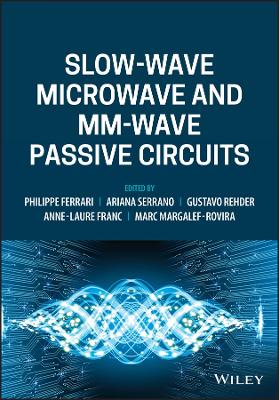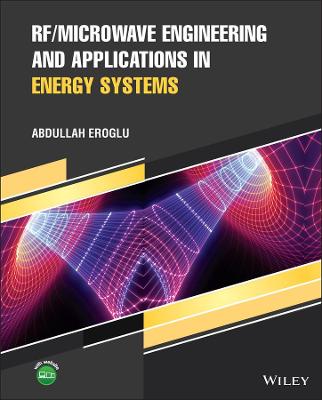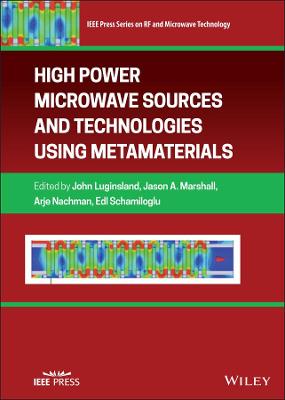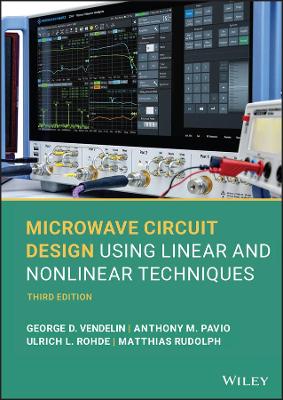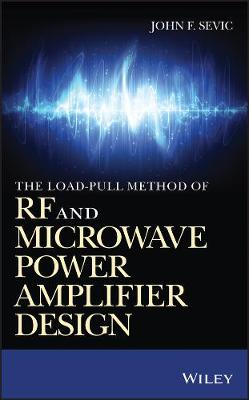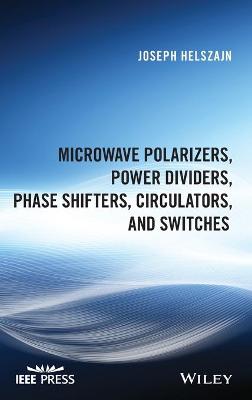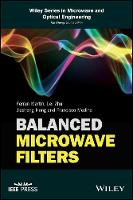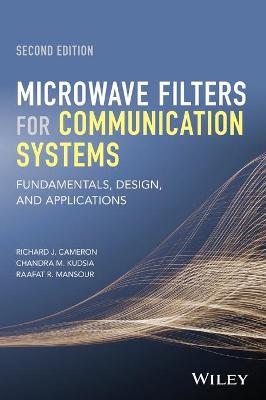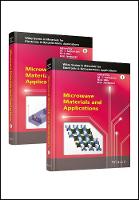RF and Microwave Circuit Design
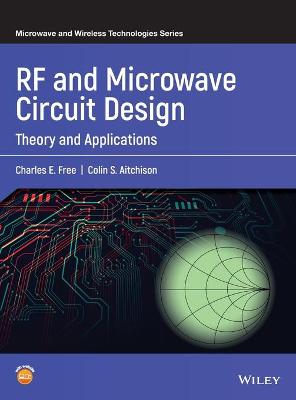 -15%
portes grátis
-15%
portes grátis
RF and Microwave Circuit Design
Theory and Applications
Free, Charles E.; Aitchison, Colin S.
John Wiley & Sons Inc
10/2021
528
Dura
Inglês
9781119114635
15 a 20 dias
1520
1. RF Transmission lines
1.0 Introduction
1.1 Voltage, current and impedance relationships on a transmission line
1.2 Propagation constant
1.2.1 Dispersion
1.2.2 Amplitude distortion
1.3 Lossless transmission lines
1.4 Matched and mismatched transmission lines
1.5 Waves on a transmission line
1.6 The Smith chart
1.6.1 Derivation of the chart
1.6.2 Properties of the chart
1.7 Stubs
1.8 Distributed matching circuits
1.9 Manipulation of lumped impedance using the Smith chart
1.10 Lumped impedance matching
1.10.1 Matching a complex load impedance to a real source impedance
1.10.2 Matching a complex load impedance to a complex source impedance
1.11 Equivalent lumped circuit of a lossless transmission line
1.12 Supplementary problems
1.13 Appendices
Appendix A1.1 Coaxial cable
A1.1.1 Electromagnetic field patterns in coaxial cable
A1.1.2 Essential properties of coaxial cables
Appendix A1.2 Coplanar waveguide
A1.2.1 Structure of coplanar waveguide (CPW)
A1.2.2 Electromagnetic field distribution on a CPW line
A1.2.3 Essential properties of coplanar (CPW) lines
A1.2.4 Summary of key points relating to CPW lines
Appendix A1.3 Metal waveguide
A1.3.1 Waveguide principles
A1.3.2 Waveguide propagation
A1.3.3 Rectangular waveguide modes
A1.3.4 The waveguide equation
A1.3.5 Phase and group velocities
A1.3.6 Field theory analysis of rectangular waveguides
A1.3.7 Waveguide impedance
A1.3.8 Higher-order rectangular waveguide modes
A1.3.9 Waveguide attenuation
A1.3.10 Sizes of rectangular waveguide, and waveguide designation
A1.3.11 Circular waveguide
Appendix A1.4 Microstrip
Appendix A1.5 Equivalent lumped circuit representation of a transmission line
References
2. Planar Circuit Design I: Designing using Microstrip
2.0 Introduction
2.1 Electromagnetic field distribution across a microstrip line
2.2 Effective relative permittivity,
2.3 Microstrip design graphs and CAD software
2.4 Operating frequency limitations
2.5 Skin depth
2.6 Examples of microstrip components
2.6.1 Branch-line coupler
2.6.2 Quarter-wave transformer
2.6.3 Wilkinson power divider
2.7 Microstrip coupled-line structures
2.7.1 Analysis of microstrip coupled lines
2.7.2 Microstrip directional couplers
2.7.2.1 Design of microstrip directional couplers
2.7.2.2 Directivity of microstrip directional couplers
2.7.2.3 Improvements to microstrip directional couplers
2.7.3 Examples of other common microstrip coupled-line structures
2.7.3.1 Microstrip DC break
2.7.3.2 Edge-coupled microstrip band-pass filter
2.7.3.3 Lange coupler
2.8 Summary
2.9 Supplementary problems
2.10 Appendix A2.1: Microstrip design graphs
References
3. Fabrication processes for RF and microwave circuits
3.1 Introduction
3.2 Review of essential materials parameters
3.2.1 Dielectrics
3.2.2 Conductors
3.3 Requirements for RF circuit materials
3.4 Fabrication of planar high-frequency circuits
3.4.1 Etched circuits
3.4.2 Thick-film circuits (direct screen printed)
3.4.3 Thick-film circuits (using photoimageable materials)
3.4.4 LTCC (low temperature co-fired ceramic) circuits
3.4.5 Use of ink jet technology
3.5 Characterization of materials for RF and microwave circuits
3.5.1 Measurement of dielectric loss and dielectric constant
3.5.1.1 Cavity resonators
3.5.1.2 Dielectric characterization by cavity perturbation
3.5.1.3 Use of the split post dielectric resonator (SPDR)
3.5.1.4 Open-resonator
3.5.1.5 Free-space transmission measurements
3.5.2 Measurement of planar line properties
3.5.2.1 The microstrip resonant ring
3.5.2.2 Non-resonant lines
3.5.3 Physical properties of microstrip lines
3.6 Supplementary problems
references
4. Planar Circuit Design II: Refinements to basic designs
4.1 Introduction
4.2 Discontinuities in microstrip
4.2.1 Open-end effect
4.2.2 Step width
4.2.3 Corners
4.2.4 Gaps
4.2.5 T-junctions
4.3 Microstrip enclosures
4.4 Packaged lumped-element passive components
4.4.1 Typical packages for RF passive components
4.4.2 Lumped-element resistors
4.4.3 Lumped-element capacitors
4.4.4 Lumped-element inductors
4.5 Miniature planar components
4.5.1 Spiral inductors
4.5.2 Loop inductors
4.5.3 Interdigitated capacitors
4.5.4 MIM (metal-insulator-metal) capacitors
4.6 Appendix 4.1: Insertion loss due to a microstrip gap
References
5. S-parameters
5.1 Introduction
5.2 S-parameter definitions
5.3 Signal flow graphs
5.4 Mason's non-touching loop rule
5.5 Reflection coefficient of a 2-port network
5.6 Power gains of two-port networks
5.7 Stability
5.8 Supplementary Problems
5.9 Appendix A5.1 Relationships between network parameters
A5.1.1 Transmission parameters (ABCD parameters)
A5.1.2 Admittance parameters (Y-parameters)
A5.1.3 Impedance parameters (Z-parameters)
References
6. Microwave Ferrites
6.1 Introduction
6.2 Basic properties of ferrite materials
6.2.1 Ferrite materials
6.2.2 Precession in ferrite materials
6.2.3 Permeability tensor
6.2.4 Faraday rotation
6.3 Ferrites in metallic waveguide
6.3.1 Resonance isolator
6.3.2 Field displacement isolator
6.3.3 Waveguide circulator
6.4 Ferrites in planar circuits
6.4.1 Planar circulators
6.4.2 Edge-guided-mode propagation
6.4.3 Edge-guided-mode isolator
6.4.4 Phase shifters
6.5 Self-biased ferrites
6.6 Supplementary problems
References
7. Measurements
7.1 Introduction
7.2 RF and Microwave connectors
7.2.1 Maintenance of connectors
7.2.2 Connecting to planar circuits
7.3 Microwave vector network analyzers
7.3.1 Description and configuration
7.3.2 Error models representing a VNA
7.3.3 Calibration of a VNA
7.4 On-wafer measurements
7.5 Summary
References
8. RF Filters
8.1 Introduction
8.2 Review of filter responses
8.3 Filter parameters
8.4 Design strategy for RF and microwave filters
8.5 Multi-element low-pass filter
8.6 Practical filter responses
8.7 Butterworth (or maximally-flat) response
8.7.1 Butterworth low-pass filter
8.7.3 Butterworth band-pass filter
8.7.3 Butterworth band-pass filter
8.8 Chebyshev (equal ripple) response
8.9 Microstrip low-pass filter, using stepped impedances
8.10 Microstrip low-pass filter, using stubs
8.11 Microstrip edge-coupled band-pass filters
8.12 Microstrip end-coupled band-pass filters
8.13 Practical points associated with filter design
8.14 Summary
8.15 Supplementary problems
8.16 Appendix A8.1 Equivalent lumped T-network representation of a transmission line
References
9. Microwave Small-Signal Amplifiers
9.1 Introduction
9.2 Conditions for matching
9.3 Distributed (microstrip) matching networks
9.4 DC biasing circuits
9.5 Microwave transistor packages
9.6 Typical hybrid amplifier
9.7 DC finger breaks
9.8 Constant gain circles
9.9 Stability circles
9.10 Noise circles
9.11 Low-noise amplifier design
9.12 Simultaneous conjugate match
9.13 Broadband matching
9.14 Summary
9.15 Supplementary problems
References
10. Switches and Phase Shifters
10.1 Introduction
10.2 Switches
10.2.1 PIN diodes
10.2.2 FETs (Field Effect Transistors)
10.2.3 MEMS (Microelectromechanical Systems)
10.2.4 IPCS (Inline Phase Change Switch) devices
10.3 Digital phase shifters
10.3.1 Switched-path phase shifter
10.3.2 Loaded-line phase shifter
10.3.3 Reflection-type phase shifter
10.3.4 Schiffman 90? phase shifter
10.3.5 Single switch phase shifter
10.4 Supplementary problems
References
11. Oscillators
11.1 Introduction
11.2 Criteria for oscillation in a feedback circuit
11.3 RF (transistor) oscillators
11.3.1 Colpitts oscillator
11.3.2 Hartley Oscillator
11.3.3 Clapp-Gouriet Oscillator
11.4 Voltage controlled oscillator (VCO)
11.5 Crystal-controlled oscillators
11.5.1 Crystals
11.5.2 Crystal-controlled oscillators
11.6 Frequency synthesizers
11.6.1 The phase-locked loop
11.6.1.1 Principle of a phase-locked loop
11.6.1.2 Main components of a phase-locked loop
11.6.1.3 Gain of a phase-locked loop
11.6.1.4 Transient analysis of a phase-locked loop
11.6.2 Indirect frequency synthesizer circuits
11.7 Microwave oscillators
11.7.1 Dielectric resonator oscillator
11.7.2 Delay line stabilized oscillator
11.7.3 Diode oscillators
11.7.3.1 Gunn diode oscillator
11.7.3.2 IMPATT diode oscillator
11.8 Oscillator noise
11.9 Measurement of oscillator noise
11.10 Supplementary problems
References
12. RF and Microwave Antennas
12.1 Introduction
12.2 Antenna parameters
12.3 Spherical polar coordinates
12.4 Radiation from a Hertzian dipole
12.4.1 Basic principles
12.4.2 Gain of a Hertzian dipole
12.5 Radiation from a half-wave dipole
12.5.1 Basic principles
12.5.2 Gain of a half-wave dipole
12.5.3 Summary of the properties of a half-wave dipole
12.6 Antenna arrays
12.7 Mutual impedance
12.8 Arrays containing parasitic elements
12.9 Yagi-Uda array
12.10 Log-periodic array
12.11 Loop antenna
12.12 Planar antennas
12.12.1 Linearly polarized patch antennas
12.12.2 Circularly polarized planar antennas
12.13 Horn antennas
12.14 Parabolic reflector antennas
12.15 Slot radiators
12.16 Supplementary problems
12.17 Appendix: Microstrip design graphs for substrates with ?r = 2.3
References
13. Power Amplifiers and Distributed Amplifiers
13.1 Introduction
13.2 Power amplifiers
13.2.1 Overview of power amplifier parameters
13.2.1.1 Power gain
13.2.1.2 Power added efficiency (PAE)
13.2.1.3 Input and output impedances
13.2.2 Distortion
13.2.2.1 Gain compression
13.2.2.2 Third-order intercept point
13.2.3 Linearization
13.2.3.1 Pre-distortion
13.2.3.2 Negative feedback
13.2.3.3 Feedforward
13.2.4 Power combining
13.2.5 Doherty amplifier
13.3 Load matching of power amplifiers
13.4 Distributed amplifiers
13.4.1 Description and principle of operation
13.4.2 Analysis
13.5 Developments in materials and packaging for power amplifiers
References
14. Receivers and Sub-Systems
14.1 Introduction
14.2 Receiver noise sources
14.2.1 Thermal noise
14.2.2 Semiconductor noise
14.3 Noise measures
14.3.1 Noise figure (F)
14.3.2 Noise temperature (Te)
14.4 Noise figure of cascaded networks
14.5 Antenna noise temperature
14.6 System noise temperature
14.7 Noise figure of a matched attenuator
14.8 Superhet receiver
14.8.1 Single-conversion superhet receiver
14.8.2 Image frequency
14.8.3 Key figures-of-merit for a superhet receiver
14.8.4 Double-conversion superhet receiver
14.8.5 Noise budget graph for a superhet receiver
14.9 Mixers
14.9.1 Basic mixer principles
14.9.2 Mixer parameters
14.9.3 Active and passive mixers
14.9.4 Single-ended diode mixer
14.9.5 Single balanced mixer
14.9.6 Double balanced mixer
14.9.7 Active FET mixers
14.10 Supplementary problems
14.11 Appendices
Appendix A14.1 Error function table
Appendix A14.2 Measurement of noise figure
References
Answers to selected supplementary problems
1. RF Transmission lines
1.0 Introduction
1.1 Voltage, current and impedance relationships on a transmission line
1.2 Propagation constant
1.2.1 Dispersion
1.2.2 Amplitude distortion
1.3 Lossless transmission lines
1.4 Matched and mismatched transmission lines
1.5 Waves on a transmission line
1.6 The Smith chart
1.6.1 Derivation of the chart
1.6.2 Properties of the chart
1.7 Stubs
1.8 Distributed matching circuits
1.9 Manipulation of lumped impedance using the Smith chart
1.10 Lumped impedance matching
1.10.1 Matching a complex load impedance to a real source impedance
1.10.2 Matching a complex load impedance to a complex source impedance
1.11 Equivalent lumped circuit of a lossless transmission line
1.12 Supplementary problems
1.13 Appendices
Appendix A1.1 Coaxial cable
A1.1.1 Electromagnetic field patterns in coaxial cable
A1.1.2 Essential properties of coaxial cables
Appendix A1.2 Coplanar waveguide
A1.2.1 Structure of coplanar waveguide (CPW)
A1.2.2 Electromagnetic field distribution on a CPW line
A1.2.3 Essential properties of coplanar (CPW) lines
A1.2.4 Summary of key points relating to CPW lines
Appendix A1.3 Metal waveguide
A1.3.1 Waveguide principles
A1.3.2 Waveguide propagation
A1.3.3 Rectangular waveguide modes
A1.3.4 The waveguide equation
A1.3.5 Phase and group velocities
A1.3.6 Field theory analysis of rectangular waveguides
A1.3.7 Waveguide impedance
A1.3.8 Higher-order rectangular waveguide modes
A1.3.9 Waveguide attenuation
A1.3.10 Sizes of rectangular waveguide, and waveguide designation
A1.3.11 Circular waveguide
Appendix A1.4 Microstrip
Appendix A1.5 Equivalent lumped circuit representation of a transmission line
References
2. Planar Circuit Design I: Designing using Microstrip
2.0 Introduction
2.1 Electromagnetic field distribution across a microstrip line
2.2 Effective relative permittivity,
2.3 Microstrip design graphs and CAD software
2.4 Operating frequency limitations
2.5 Skin depth
2.6 Examples of microstrip components
2.6.1 Branch-line coupler
2.6.2 Quarter-wave transformer
2.6.3 Wilkinson power divider
2.7 Microstrip coupled-line structures
2.7.1 Analysis of microstrip coupled lines
2.7.2 Microstrip directional couplers
2.7.2.1 Design of microstrip directional couplers
2.7.2.2 Directivity of microstrip directional couplers
2.7.2.3 Improvements to microstrip directional couplers
2.7.3 Examples of other common microstrip coupled-line structures
2.7.3.1 Microstrip DC break
2.7.3.2 Edge-coupled microstrip band-pass filter
2.7.3.3 Lange coupler
2.8 Summary
2.9 Supplementary problems
2.10 Appendix A2.1: Microstrip design graphs
References
3. Fabrication processes for RF and microwave circuits
3.1 Introduction
3.2 Review of essential materials parameters
3.2.1 Dielectrics
3.2.2 Conductors
3.3 Requirements for RF circuit materials
3.4 Fabrication of planar high-frequency circuits
3.4.1 Etched circuits
3.4.2 Thick-film circuits (direct screen printed)
3.4.3 Thick-film circuits (using photoimageable materials)
3.4.4 LTCC (low temperature co-fired ceramic) circuits
3.4.5 Use of ink jet technology
3.5 Characterization of materials for RF and microwave circuits
3.5.1 Measurement of dielectric loss and dielectric constant
3.5.1.1 Cavity resonators
3.5.1.2 Dielectric characterization by cavity perturbation
3.5.1.3 Use of the split post dielectric resonator (SPDR)
3.5.1.4 Open-resonator
3.5.1.5 Free-space transmission measurements
3.5.2 Measurement of planar line properties
3.5.2.1 The microstrip resonant ring
3.5.2.2 Non-resonant lines
3.5.3 Physical properties of microstrip lines
3.6 Supplementary problems
references
4. Planar Circuit Design II: Refinements to basic designs
4.1 Introduction
4.2 Discontinuities in microstrip
4.2.1 Open-end effect
4.2.2 Step width
4.2.3 Corners
4.2.4 Gaps
4.2.5 T-junctions
4.3 Microstrip enclosures
4.4 Packaged lumped-element passive components
4.4.1 Typical packages for RF passive components
4.4.2 Lumped-element resistors
4.4.3 Lumped-element capacitors
4.4.4 Lumped-element inductors
4.5 Miniature planar components
4.5.1 Spiral inductors
4.5.2 Loop inductors
4.5.3 Interdigitated capacitors
4.5.4 MIM (metal-insulator-metal) capacitors
4.6 Appendix 4.1: Insertion loss due to a microstrip gap
References
5. S-parameters
5.1 Introduction
5.2 S-parameter definitions
5.3 Signal flow graphs
5.4 Mason's non-touching loop rule
5.5 Reflection coefficient of a 2-port network
5.6 Power gains of two-port networks
5.7 Stability
5.8 Supplementary Problems
5.9 Appendix A5.1 Relationships between network parameters
A5.1.1 Transmission parameters (ABCD parameters)
A5.1.2 Admittance parameters (Y-parameters)
A5.1.3 Impedance parameters (Z-parameters)
References
6. Microwave Ferrites
6.1 Introduction
6.2 Basic properties of ferrite materials
6.2.1 Ferrite materials
6.2.2 Precession in ferrite materials
6.2.3 Permeability tensor
6.2.4 Faraday rotation
6.3 Ferrites in metallic waveguide
6.3.1 Resonance isolator
6.3.2 Field displacement isolator
6.3.3 Waveguide circulator
6.4 Ferrites in planar circuits
6.4.1 Planar circulators
6.4.2 Edge-guided-mode propagation
6.4.3 Edge-guided-mode isolator
6.4.4 Phase shifters
6.5 Self-biased ferrites
6.6 Supplementary problems
References
7. Measurements
7.1 Introduction
7.2 RF and Microwave connectors
7.2.1 Maintenance of connectors
7.2.2 Connecting to planar circuits
7.3 Microwave vector network analyzers
7.3.1 Description and configuration
7.3.2 Error models representing a VNA
7.3.3 Calibration of a VNA
7.4 On-wafer measurements
7.5 Summary
References
8. RF Filters
8.1 Introduction
8.2 Review of filter responses
8.3 Filter parameters
8.4 Design strategy for RF and microwave filters
8.5 Multi-element low-pass filter
8.6 Practical filter responses
8.7 Butterworth (or maximally-flat) response
8.7.1 Butterworth low-pass filter
8.7.3 Butterworth band-pass filter
8.7.3 Butterworth band-pass filter
8.8 Chebyshev (equal ripple) response
8.9 Microstrip low-pass filter, using stepped impedances
8.10 Microstrip low-pass filter, using stubs
8.11 Microstrip edge-coupled band-pass filters
8.12 Microstrip end-coupled band-pass filters
8.13 Practical points associated with filter design
8.14 Summary
8.15 Supplementary problems
8.16 Appendix A8.1 Equivalent lumped T-network representation of a transmission line
References
9. Microwave Small-Signal Amplifiers
9.1 Introduction
9.2 Conditions for matching
9.3 Distributed (microstrip) matching networks
9.4 DC biasing circuits
9.5 Microwave transistor packages
9.6 Typical hybrid amplifier
9.7 DC finger breaks
9.8 Constant gain circles
9.9 Stability circles
9.10 Noise circles
9.11 Low-noise amplifier design
9.12 Simultaneous conjugate match
9.13 Broadband matching
9.14 Summary
9.15 Supplementary problems
References
10. Switches and Phase Shifters
10.1 Introduction
10.2 Switches
10.2.1 PIN diodes
10.2.2 FETs (Field Effect Transistors)
10.2.3 MEMS (Microelectromechanical Systems)
10.2.4 IPCS (Inline Phase Change Switch) devices
10.3 Digital phase shifters
10.3.1 Switched-path phase shifter
10.3.2 Loaded-line phase shifter
10.3.3 Reflection-type phase shifter
10.3.4 Schiffman 90? phase shifter
10.3.5 Single switch phase shifter
10.4 Supplementary problems
References
11. Oscillators
11.1 Introduction
11.2 Criteria for oscillation in a feedback circuit
11.3 RF (transistor) oscillators
11.3.1 Colpitts oscillator
11.3.2 Hartley Oscillator
11.3.3 Clapp-Gouriet Oscillator
11.4 Voltage controlled oscillator (VCO)
11.5 Crystal-controlled oscillators
11.5.1 Crystals
11.5.2 Crystal-controlled oscillators
11.6 Frequency synthesizers
11.6.1 The phase-locked loop
11.6.1.1 Principle of a phase-locked loop
11.6.1.2 Main components of a phase-locked loop
11.6.1.3 Gain of a phase-locked loop
11.6.1.4 Transient analysis of a phase-locked loop
11.6.2 Indirect frequency synthesizer circuits
11.7 Microwave oscillators
11.7.1 Dielectric resonator oscillator
11.7.2 Delay line stabilized oscillator
11.7.3 Diode oscillators
11.7.3.1 Gunn diode oscillator
11.7.3.2 IMPATT diode oscillator
11.8 Oscillator noise
11.9 Measurement of oscillator noise
11.10 Supplementary problems
References
12. RF and Microwave Antennas
12.1 Introduction
12.2 Antenna parameters
12.3 Spherical polar coordinates
12.4 Radiation from a Hertzian dipole
12.4.1 Basic principles
12.4.2 Gain of a Hertzian dipole
12.5 Radiation from a half-wave dipole
12.5.1 Basic principles
12.5.2 Gain of a half-wave dipole
12.5.3 Summary of the properties of a half-wave dipole
12.6 Antenna arrays
12.7 Mutual impedance
12.8 Arrays containing parasitic elements
12.9 Yagi-Uda array
12.10 Log-periodic array
12.11 Loop antenna
12.12 Planar antennas
12.12.1 Linearly polarized patch antennas
12.12.2 Circularly polarized planar antennas
12.13 Horn antennas
12.14 Parabolic reflector antennas
12.15 Slot radiators
12.16 Supplementary problems
12.17 Appendix: Microstrip design graphs for substrates with ?r = 2.3
References
13. Power Amplifiers and Distributed Amplifiers
13.1 Introduction
13.2 Power amplifiers
13.2.1 Overview of power amplifier parameters
13.2.1.1 Power gain
13.2.1.2 Power added efficiency (PAE)
13.2.1.3 Input and output impedances
13.2.2 Distortion
13.2.2.1 Gain compression
13.2.2.2 Third-order intercept point
13.2.3 Linearization
13.2.3.1 Pre-distortion
13.2.3.2 Negative feedback
13.2.3.3 Feedforward
13.2.4 Power combining
13.2.5 Doherty amplifier
13.3 Load matching of power amplifiers
13.4 Distributed amplifiers
13.4.1 Description and principle of operation
13.4.2 Analysis
13.5 Developments in materials and packaging for power amplifiers
References
14. Receivers and Sub-Systems
14.1 Introduction
14.2 Receiver noise sources
14.2.1 Thermal noise
14.2.2 Semiconductor noise
14.3 Noise measures
14.3.1 Noise figure (F)
14.3.2 Noise temperature (Te)
14.4 Noise figure of cascaded networks
14.5 Antenna noise temperature
14.6 System noise temperature
14.7 Noise figure of a matched attenuator
14.8 Superhet receiver
14.8.1 Single-conversion superhet receiver
14.8.2 Image frequency
14.8.3 Key figures-of-merit for a superhet receiver
14.8.4 Double-conversion superhet receiver
14.8.5 Noise budget graph for a superhet receiver
14.9 Mixers
14.9.1 Basic mixer principles
14.9.2 Mixer parameters
14.9.3 Active and passive mixers
14.9.4 Single-ended diode mixer
14.9.5 Single balanced mixer
14.9.6 Double balanced mixer
14.9.7 Active FET mixers
14.10 Supplementary problems
14.11 Appendices
Appendix A14.1 Error function table
Appendix A14.2 Measurement of noise figure
References
Answers to selected supplementary problems

